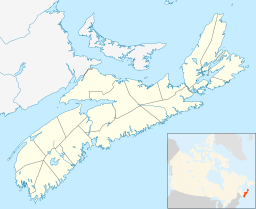Tangier Grand Lake facts for kids
Tangier Grand Lake is a beautiful lake located in the Halifax Regional Municipality in Nova Scotia, Canada. It's found close to a small community called Mooseland, Nova Scotia. This lake is a natural wonder, known for its many islands and interesting features.
Quick facts for kids Tangier Grand Lake |
|
|---|---|
| Location | Halifax Regional Municipality, Nova Scotia |
| Coordinates | 44°53′18″N 62°49′01″W / 44.888369°N 62.816891°W |
| Type | Glacial Lake |
| Primary outflows | Three Rivers Lake, then Tangier River |
| Basin countries | Canada |
| Max. length | 6 kilometres (3.7 mi) |
| Max. width | 4 kilometres (2.5 mi) |
| Average depth | ~ 5 metres (16 ft) |
| Max. depth | 30 metres (98 ft) |
| Surface elevation | 60 metres (200 ft) |
| Islands | Many islands, large and small, scattered throughout the lake |
About Tangier Grand Lake
Tangier Grand Lake is a large body of fresh water. It stretches about 6 kilometres (3.7 mi) long and 4 kilometres (2.5 mi) wide. The lake is quite shallow in most places, with an average depth of about 5 metres (16 ft). However, there is one special spot in the middle that goes much deeper, reaching about 30 metres (98 ft).
Islands of the Lake
One of the most interesting things about Tangier Grand Lake is its many islands. These islands come in all sizes. The largest island is quite big, measuring about 600 metres (2,000 ft) long and 300 metres (980 ft) wide. You can find islands scattered all over the lake, especially in its western and eastern parts.
How the Lake Was Formed
Tangier Grand Lake is a type of lake called a "Glacial Lake." This means it was formed a very long time ago by huge sheets of ice, known as glaciers. As these glaciers moved across the land, they carved out valleys and depressions. When the glaciers melted, these hollows filled with water, creating lakes like Tangier Grand Lake.
The lake sits on an area called the Eastern Shore Granite Ridge. This ridge is made of very old rock, about 350 million years old, called granite bedrock. The hard granite helped shape the lake's basin as the glaciers moved over it.


